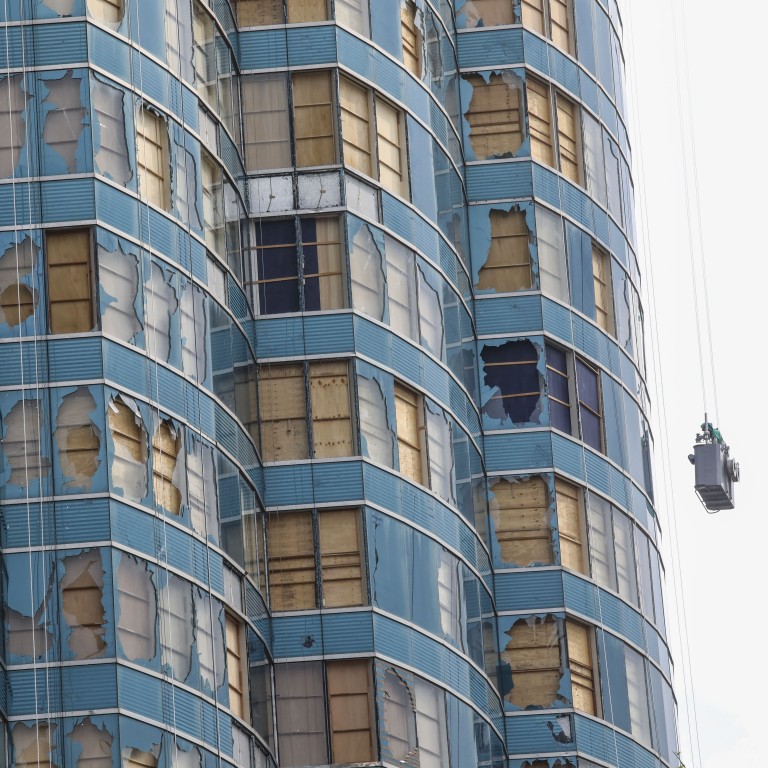
Hong Kong trails Singapore, Christchurch in climate change readiness, thanks to its housing crisis
- Losses owed to extreme weather patterns are estimated to have hit US$200 billion globally in 2018
Hong Kong lags behind Singapore and other cities when it comes to preparation for climate change challenges, such as typhoons and flooding, according to Sean Tompkins, chief executive of the Royal Institution of Chartered Surveyors.
He said the city’s housing problem was to blame. “If you look at Hong Kong, there’s no doubt the developers are looking at issues around sustainability and resilience. The government is increasingly looking at this and it’s getting higher up the priority list. But is there any central coordination and control around resilience? Not as much as you would see in other parts of the world,” said Tompkins, who added that the city had yet to appoint a chief resilience officer.
Hong Kong’s annual global warming bill is HK$22 billion, but do we have the will to pay it?
He said Singapore and Christchurch in New Zealand were leaders in resilience initiatives. For instance, Singapore-listed City Development Limited began taking initiatives in 1995 under its “conserving as we construct” tenet, and created prefabricated building technology that reduced energy use.
Twenty-one cities in Asia-Pacific, including Deyang and Huangshi in mainland China, are members of the 100 Resilient Cities organisation, which helps cities craft plans to become more resilient to shocks such as earthquakes, fires, floods and other social and economic challenges.
In Europe, businesses may soon be required to disclose climate risks as they ultimately affect the value of assets. Meanwhile, more than 60 cities have appointed a chief resilience officer, who initiates resilience strategies.
Losses owed to extreme weather patterns are estimated to have hit US$200 billion globally in 2018. Over the past 30 years, these losses have increased fourfold. “That doesn't necessarily include the cost to human life and the cost to local communities,” said Tompkins.
In September 2018, Hong Kong was hit by Typhoon Mangkhut, the most powerful storm since records began in 1946. Tompkins said across Asia, damage from the typhoon was pegged at US$2 billion.
Hong Kong, he said, was facing a housing crisis, with limited supply and skyrocketing prices, and that the government and developers were focused on addressing these issues.
“Clearly, there is that pressure, so maybe severe climate change and big climate risks are not as high up [the priority list] as the agenda of housing,” he said. According to a recent study, it will take about 21 years for a family to save enough money to buy a home in Hong Kong.
Maybe severe climate change and big climate risks are not as high up [the priority list] as the agenda of housing
Tompkins said stakeholders should think long term and adopt best practices in building projects. “If you only look at ‘how much does it cost me to build this’ and if you answer ‘how much does this cost me to run over 40 to 50 years of the building cycle’, then you can start to find a business case to build a more sustainable and energy-efficient project,” he said.
Simon Chua, co-founder and executive director of architecture and design firm Lead8, too said stakeholders could do more to ensure the resilience of projects in the city.
“The government has a lot of resources. Our public transport is one of the world’s best,” said Chua, giving the example of the city’s rail links to the airport. But he said the transport infrastructure could be utilised better if it was integrated with housing estates.
Chua said the government should work with developers to ensure projects are secured on the basis of good designs, rather than the highest bidder. He said developers are discouraged to be innovative in their designs as land prices in the city are expensive.
One of the challenges Hong Kong faces is its ageing population, and integrated mixed-use developments could address this by building education, medical and sports facilities together so that the elderly and the young can interact, said Chua.
The Hong Kong government, however, said it has taken steps to prepare the city and its population for extreme climate change.
In a written response to a request for comment by the South China Morning Post, a spokeswoman for the Environment Bureau said a committee and an interdepartmental group had been set up to coordinate climate action and oversee the creation of new design standards to strengthen public works and infrastructure, respectively.
Under the two groups, the spokeswoman said, rising global sea levels and storm surges were to be given priority.
Hong Kong has also actively taken part in international communities to combat climate change, such as C40 Cities Climate Leadership Group, since 2007, and the Conferences of the Parties to the United Nations Framework Convention on Climate Change.

